Fascinating Insights into Bottlenose Dolphins
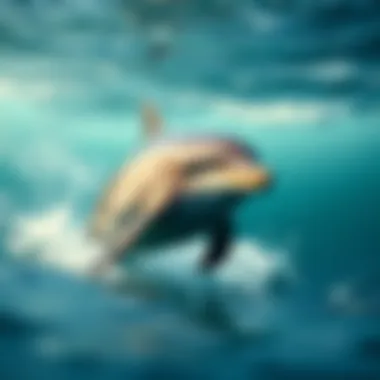
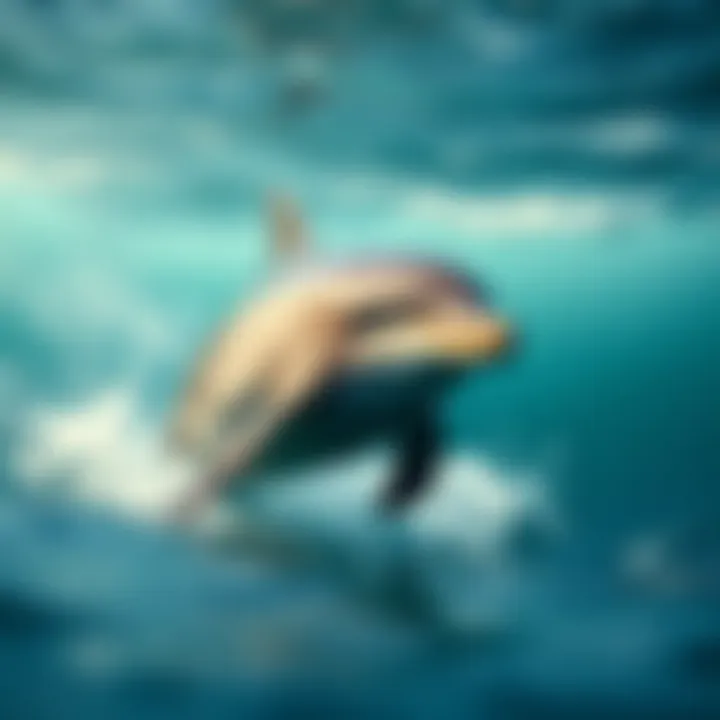
Intro
Bottlenose dolphins, often seen frolicking in coastal waters, are not just cute creatures that delight beachgoers. These marine mammals are complex beings brimming with intellect and sociality, showcasing behaviors that capture the curiosity of marine biologists and enthusiasts alike. With their sleek bodies slicing effortlessly through waves, they've garnered a reputation that far surpasses merely their delightful antics. For those willing to delve deeper, a fascinating world lies beneath the surface, shedding light on what makes these dolphins remarkable.
This article aims to explore various facets of bottlenose dolphins, including their intelligence, social structures, communication styles, adaptive behaviors, and the hurdles they face in conservation. Each section will unravel the mysteries behind these creatures, painting a picture of their lives in intricate detail. By understanding the complexities of bottlenose dolphins, we can appreciate their role within marine ecosystems, their interaction with humans, and the intrinsic value they add to our natural world.
Intelligence of Bottlenose Dolphins
If there's one aspect that sets bottlenose dolphins apart, it's their intelligence, which is often likened to that of primates. Their ability to solve problems, engage in play, and even use tools demonstrates a level of cognitive functioning that is extraordinary among marine life. Studies have shown that these dolphins can recognize themselves in mirrors, indicating a strong sense of self—elusive for many living beings. The nuances of their intelligence are layered like shells on a beach, each telling a different story of their capabilities.
Learning and Problem Solving
From young age, bottlenose dolphins exhibit remarkable learning skills. Not only do they learn through imitation, but they also figure things out in collaboration with their peers. When faced with challenges such as extraction of prey from complex environments, they devise strategies that showcase both critical thinking and teamwork.
"Dolphins are able to find solutions to problems by communicating and working together, reflecting one of their most fascinating traits."
This cooperative spirit enhances their survival skills. For instance, when hunting, they may use a method called mud-ring feeding, where they create a swirling vortex to trap fish. It’s not only a testament to their ingenuity but also signifies their ability to pass down knowledge through generations.
Social Structures
The social lives of bottlenose dolphins might be one of the most intricate facets of their existence. Living in pods, these groups can range from a few individuals to over a hundred, depending on the resources available and other environmental factors. Within these pods, social hierarchies emerge. Dolphins form tight bonds with one another, often seen engaging in playful acts, which strengthen their social networks.
Communication Dynamics
Dolphins possess a rich array of vocalizations and body language that facilitate their interactions. They communicate using whistles, clicks, and even physical gestures, akin to a complex language tailored to their aquatic environment. Each dolphin has a unique whistle that acts as an auditory signature, helping them to identify each other seamlessly, just like humans recognize voices.
Furthermore, it's been noted that dolphins can utilize a range of sounds not only for socialization but also for echolocation, illuminating their environment in the most effective manner.
Adaptive Behaviors
Bottlenose dolphins are adept at adapting to various challenges that their surroundings present. They exhibit a wide range of behaviors, which reflect their resilient nature in the face of ecological change. Whether it’s foraging in diverse habitats or dealing with competition among species, their adaptability is noteworthy.
Regional Behavior Differences
Depending on their habitat—coastal waters or open seas—different populations of bottlenose dolphins develop distinct behaviors. Some may specialize in hunting fish, while others might forage for cephalopods. Researchers have documented these variances, noting that specific dolphin groups may even develop unique hunting techniques—these adaptations ensure they thrive in varying conditions.
Conservation Challenges
Despite their robust nature, bottlenose dolphins face significant threats that jeopardize their existence. From environmental pollution to habitat loss, their survival is increasingly under siege. Issues such as bycatch in fishing nets, climate change, and tourism-related disturbances contribute to their population decline.
Importance of Preservation
Preserving bottlenose dolphins is vital, not only for maintaining biodiversity but also for protecting the coastal ecosystems they inhabit. As key players in their environment, their presence influences everything from fish stocks to nutrient cycling. Conservation efforts, therefore, must focus on both protecting these dolphins and promoting sustainable practices that minimize human impact.
Through our deep dive into the world of bottlenose dolphins, it becomes clear why these creatures are deserving of admiration and protection. Understanding their intelligence, social structures, communication methods, adaptive capabilities, and conservation struggles gives us insight into their significance. As we venture further into this article, let’s discover the myriad ways we can help secure a future for these remarkable marine mammals.
Intro to Bottlenose Dolphins
Bottlenose dolphins, known scientifically as Tursiops truncatus, hold a distinct place in the marine world, both in biology and in the public consciousness. These fascinating creatures are not merely subjects of scientific inquiry but also essential contributors to marine ecosystems. Understanding them goes beyond the surface of just their physical attributes; it entails a deep dive into their intelligence, social behaviors, and role in the environment. This makes the study of bottlenose dolphins critical for several reasons.
Firstly, they serve as indicators of marine health. Their presence and behavior can offer insights into the quality of the surrounding marine environment, allowing scientists and conservationists to gauge ecosystem health. When dolphin populations are thriving, it's a good sign the ecosystem is in balance, whereas declines can hint at issues such as pollution or overfishing.
Moreover, bottlenose dolphins exhibit remarkable cognitive abilities that challenge our understanding of intelligence in non-human species. Their problem-solving skills, social dynamics within pods, and even their complex forms of communication not only pique scientific interest but also enrich our understanding of animal behavior and social structures.
In addition, bottlenose dolphins frequently feature in literature, folklore, and media across various cultures, enhancing their significance beyond just an ecological context. They symbolize not only playfulness and grace but also the intricate relationships between humanity and nature. Ultimately, grasping the intricacies of bottlenose dolphins can deepen our appreciation for marine life and inform conservation strategies aimed at preserving these captivating mammals in the wild.
Overview of Species
Bottlenose dolphins belong to the family Delphinidae, which encompasses various species of dolphins, but bottlenose are among the most well-known. They typically range from 8 to 12 feet in length, exhibiting a robust body and a distinctive curved mouth that gives them their characteristic "smiling" appearance. Their skin is sleek, usually a gray color with lighter underbellies. The skin can even vary in shades based on geographical locations, allowing for some fascinating discussions about evolution and adaptation.
Characteristic traits also include the dorsal fin, which can be quite prominent; in adults, it often resembles a sickle in shape. As well, these dolphins possess a remarkable capacity for echolocation, allowing them to navigate and hunt in their aquatic environment effectively. Their social behavior is one of the most captivating aspects, as they often travel in pods that can number from just a few to over a hundred individuals, showcasing their complex social structures.
Habitat and Distribution
Bottlenose dolphins are highly adaptable and can be found in a variety of marine environments ranging from coastal waters to deep oceans. They often inhabit areas near shorelines, estuaries, and bays, thriving in warm, temperate oceans. These regions provide abundant food sources and suitable conditions for social interaction.
The distribution of bottlenose dolphins is fairly widespread. They are found in both the Atlantic and Pacific Oceans. Notably, they are often spotted in areas such as the Gulf of Mexico, the Mediterranean Sea, and around the coastlines of Australia and New Zealand. Their adaptability is key to their ability to thrive in such diverse environments.
- Key Habitats Include:


- Coastal marine waters
- Rivermouths and estuaries
- Sheltered bays
However, despite their wide distribution, local populations can face various threats, such as habitat degradation due to pollution, boating traffic, and climate change, leading to habitat loss. Thus, continued research into their habitats and distribution is vital for their conservation.
"Understanding the habitat and behavior of bottlenose dolphins can pave the way for effective marine conservation efforts."
In summary, bottlenose dolphins are more than just charismatic megafauna of the ocean; they are vital players in the marine ecosystem. As we move forward in our exploration of their lives and challenges, it is essential to appreciate both the beauty and the wit of these remarkable creatures.
Cognitive Abilities
The cognitive abilities of bottlenose dolphins have captivated not only marine biologists but also a wide range of enthusiasts across the globe. These remarkable mammals showcase a level of intelligence that often mirrors human-like thinking processes. Understanding their cognitive strengths offers vital insights into their behavior, communication, and social interactions, which is crucial for those aiming to protect them in their natural habitats. By recognizing their mental capabilities, we can appreciate the larger implications of their role in the marine ecosystem as well as develop effective conservation strategies.
Problem Solving Skills
Bottlenose dolphins exhibit a problem-solving acumen that can sometimes resemble that of a playful child at play. They can tackle complex challenges, whether it involves navigating through intricate underwater structures or hunting for food using teamwork. One notable example is the way they sometimes collaborate to herd fish, utilizing sophisticated tactics that require communication and strategic planning. This behavior not only highlights their intelligence but also underscores their social bonds, as teamwork becomes a vital component of achieving shared goals.
Imagine a group of dolphins working together: one pushes the fish towards the others, while a second one circles around to guide the school into a tight ball. These tactical maneuvers reveal advanced thinking and reflect a deep understanding of both their own capabilities and those of their peers. This insight into their problem-solving skills points to a more nuanced understanding of dolphin intelligence and raises questions about their emotional lives as well.
Tool Use in Behavior
The use of tools among bottlenose dolphins might not be as prominent as seen in some primate species, yet it is no less fascinating. Dolphins have been observed using marine sponges to protect their snouts while foraging on the ocean floor, a behavior that showcases their ability to creatively adapt to their environment.
Why does this matter?
This tool-use behavior speaks volumes about their intelligence and their capacity to understand cause and effect in their surroundings. By leveraging tools, dolphins improve their foraging efficiency significantly, allowing them to access resources otherwise out of reach.
Several studies have documented this behavior, indicating that dolphins learn this technique through social learning. Young dolphins watch their mothers and peers using tools, absorbing this knowledge that benefits their survival. This kind of cultural transmission is a testament to their social structure and raises questions about how intelligence varies among different dolphin pods.
Through such behaviors, bottlenose dolphins demonstrate that their cognitive abilities extend far beyond mere instinct and impulse, signaling a complex interplay between learning, problem-solving, and social interaction. This layer of behavior contributes to their overall role in the marine ecosystem and provides a unique perspective on their innate capabilities, making them worthy subjects for further research and conservation efforts.
"Bottlenose dolphins exhibit cognitive abilities that reflect not only intelligence but also a nuanced understanding of their social environment."
Further Reading:
- Wikipedia on Bottlenose Dolphins
- National Oceanic and Atmospheric Administration
- Marine Mammal Science Journal
Understanding these aspects of bottlenose dolphins not only enriches our knowledge about these creatures but also underscores the importance of their conservation.
Complex Social Structures
Bottlenose dolphins are remarkable for their intricate social organizations. Understanding these complex social structures is essential; they play a significant role in how these creatures interact, collaborate, and thrive within their marine environment. The social dynamics of bottlenose dolphins offer insights into their behavior, cognitive abilities, and overall well-being.
Dolphins are not solitary in nature; instead, they live in groups known as pods. These pods can vary greatly in size and composition and are often integral to the survival of individual dolphins. The strength of social bonds within a pod contributes to their hunting efficiency, reproductive success, and protection from predators.
Pod Dynamics
The dynamics within a dolphin pod are multilayered and fascinating. Each pod can consist of anywhere from a few dolphins to several dozen, coming together for a variety of reasons. For one thing, smaller groups often exhibit a tighter bond due to shared experiences and joint efforts, like hunting and caring for young. Dolphins within these pods are known to develop their own unique ways of communicating and interacting that can differ from other pods, leading to a strong sense of identity.
Moreover, these pods operate with fluidity; members can shift between different groups based on social interactions or environmental conditions. Such transitions underscore the adaptability of dolphins to their social environments, allowing for greater flexibility in their relationships. The social learning that arises from these dynamics helps young dolphins acquire vital skills and knowledge.
Hierarchy and Roles
Hierarchy among bottlenose dolphins is often established through interactions, rather than rigidly defined roles. Within a pod, dominant individuals may emerge, frequently based on size or strength, yet social rank can fluidly change as relationships evolve. Females, in particular, often play crucial leadership roles, especially when it comes to nurturing the young and making collective decisions about foraging and migration.
Roles can also be seen in specific activities, such as cooperative hunting, where dolphins exhibit remarkable teamwork to corral fish into tight groups. Such strategies require each member to understand its duties and execute them effectively.
- Cooperative Hunting: By coordinating their movements, dolphins can effectively herd schools of fish, making it easier to catch them.
- Caregiving: Older female dolphins often take on the role of caregivers, ensuring the survival of calves, teaching them vital skills and social behaviors.
Ultimately, the nuanced social systems of bottlenose dolphins exhibit a rich tapestry of relationships and roles that not only bolster their survival but also illuminate the complexities of marine life. This intricate web of connections plays a major role in fostering their intelligence and adaptability, underpinning why bottlenose dolphins are celebrated both in the wild and in various cultures around the globe.
"The social fabric of bottlenose dolphins reflects their intelligence and adaptability, highlighting the need for conservation."
For more information on dolphin social structures, visit Wikipedia.
For further studies on marine biology, check out Britannica.
Communication Techniques
Communication is crucial for bottlenose dolphins. It’s more than just noise; it’s their way of connecting with each other, navigating their world, and even forging bonds with humans. The intricate web of sounds and gestures they use serves multiple purposes. Whether they’re hunting, socializing, or warning one another of danger, an understanding of how dolphins communicate reveals much about their lives and intelligence.
Vocalizations and Clicks
Bottlenose dolphins possess a stunning array of vocalizations. Their sounds range from whistles to clicks and even to a sort of unique language that varies among pods. Clicks are especially fascinating because they function as a form of echolocation. When a dolphin emits a click, it sends out sound waves that bounce off objects in the water and return to the dolphin. This helps them understand their environment, locate prey, and avoid obstacles.
- Whistles: Each dolphin has a signature whistle, allowing them to call out to specific individuals in the pod. This can be likened to a name, unique to each dolphin.
- Clicks: These can travel significant distances underwater, allowing dolphins to communicate even when separated by short distances.
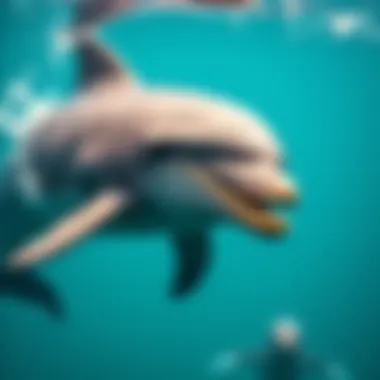
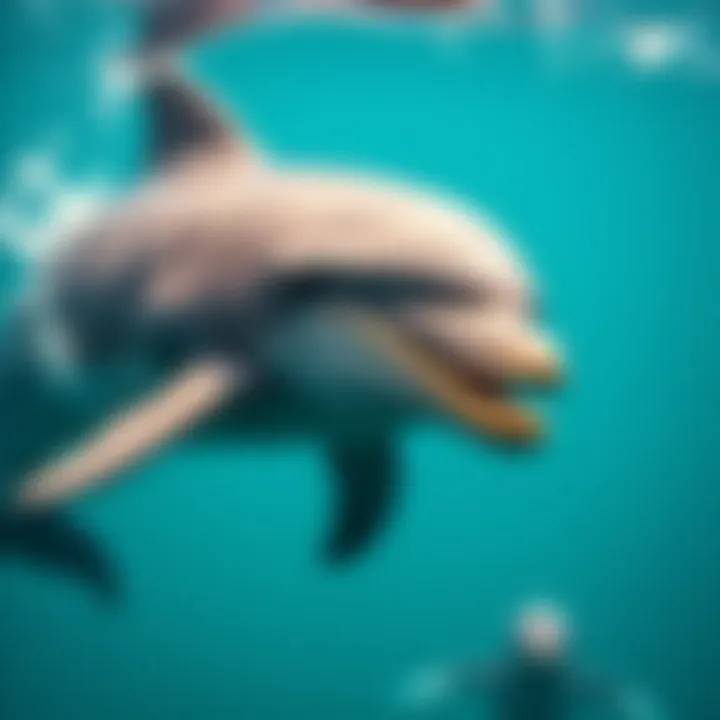
"The complexity of dolphin vocalization parallels human speech, hinting at sophisticated social structures and the need for effective communication."
Listening to dolphins in the wild often reveals the depth of their cooperation and intelligence. For example, a dolphin may signal others to gather for a coordinated hunt, showcasing their understanding of teamwork.
Non-verbal Communication
Non-verbal cues complement the vocal communications amongst bottlenose dolphins. Their body language tells stories. For instance, when dolphins leap or spin, it signifies excitement, which could be due to playful interactions or drafting behind boats. Posture can indicate aggression or submission, providing context to their vocalizations.
Some vital aspects of non-verbal communication include:
- Physical Touch: Dolphins often engage in physical contact, which promotes social bonds. Rubbing against each other is common, akin to a hug among friends.
- Acrobatic Displays: Through leaps and flips, dolphins convey joy or indicate an invitation to play.
- Facial Expressions: Although subtle, the slight movements of their facial muscles can communicate emotions that words cannot express.
Understanding these communication techniques illuminates how bottlenose dolphins interact not just with each other but also with their surroundings and, occasionally, with humans. Their ability to convey meaning through sound and gestures reflects their advanced cognitive skills and social awareness, further emphasizing why they continue to captivate and fascinate those who study and observe them.
For more information about dolphin communication methods, you can visit National Oceanic and Atmospheric Administration and Smithsonian Ocean.
Understanding these elements of dolphin communication is vital not only for marine biology but also for ensuring their conservation. As we learn more about how they interact, we can better protect their habitats and promote a deeper appreciation for these remarkable beings.
Physical Adaptations
Understanding the physical adaptations of bottlenose dolphins is crucial to appreciating how these marine mammals navigate their aquatic homes and the environment's demands. Their anatomy is a masterclass in evolution, fine-tuned for survival and success in the ocean. From their sleek bodies that allow for swift movements through water to specialized features crucial for hunting and communication, every aspect of their form is designed with purpose.
Streamlined Bodies
Bottlenose dolphins have bodies that are built for speed and agility. Their streamlined shapes reduce drag as they swim, enabling them to reach speeds of up to 25 miles per hour. This swift maneuverability isn’t just for show; it can be a matter of life and death in the wild, allowing them to evade predators or to catch fast-swimming prey. Adding to their advantage, these dolphins possess a layer of blubber beneath their skin that provides insulation against the cold of the ocean depths while also storing energy for prolonged foraging sessions.
"A streamlined body is not merely an aesthetic feature for bottlenose dolphins; it is their ticket to a life of agility, survival, and play within the vast ocean playground."
The dorsal fin, another characteristic feature, aids in maintaining stability while swimming fast. It also serves as a thermal regulator, helping to dissipate excess body heat. Interestingly, as dolphins grow older, the shape and size of the dorsal fin may change, providing insights into their age and health.
Sense of Echolocation
Bottlenose dolphins boast an extraordinary sense of echolocation, a vital adaptation that allows them to perceive their surroundings in murky waters where visibility is poor. They emit a series of clicks, which travel through the water, bouncing off objects and returning as echoes. By analyzing these echoes, dolphins can identify obstacles, locate prey, and even gauge distances, much like the radar used in aviation.
This intricate system is not just a blind-stumble mechanism, it is a sophisticated sensory tool that enhances their hunting prowess. For instance, during foraging, a bottlenose dolphin may use echolocation to differentiate between various types of fish, determining which ones are worth pursuing based on their size and distance.
The reliance on echolocation also speaks volumes about their social behavior. Dolphins often collaborate while hunting, using their echolocation capabilities to communicate effectively with pod mates about the positioning of schools of fish. This collaboration highlights the social bonds within pods and their survival strategies based on shared skills.
In summary, physical adaptations like streamlined bodies and echolocation are not merely features of bottlenose dolphins; they are essential tools for thriving in their challenging environments, fostering social bonds, and ensuring the sustenance of their species.
Role in Ecosystems
Bottlenose dolphins play a vital role in their ecosystems, acting as apex predators that help maintain the balance of marine life. Their presence is a strong indicator of a healthy marine environment. By understanding their role, we gain insights into the overall health of ocean ecosystems. They help control fish populations and influence the dynamics of marine communities, impacting various species from small fish to larger predators.
Predatory Relationships
Bottlenose dolphins primarily feed on fish and invertebrates, which makes them key players in the food web. These dolphins often exhibit sophisticated hunting techniques, such as coordinated group strategies, where they work together to herd fish into tight groups, making them easier to catch. This behavior is akin to a well-choreographed dance, showcasing their intelligence and social cooperation.
"Without dolphins, certain fish populations could explode, leading to overgrazing on habitats like seagrass, which rely on a healthy population turnover to stay vibrant."
In addition to regulating fish populations, bottlenose dolphins also serve as prey for larger marine animals, such as sharks and orcas. This predator-prey relationship is critical in maintaining the balance of marine biodiversity. The interaction between these species ensures that no single group dominates the ecosystem, which could lead to a decline in overall biodiversity.
Some marine biologists have noted that when dolphin populations are healthy, they can effectively contribute to the ecological balance. Additionally, their predatory behaviors can influence the behavior and distribution of their prey, often resulting in a more diverse and stable marine community.
Impact on Marine Biodiversity
Dolphins are not just hunters; they also contribute significantly to the maintenance of marine biodiversity. Their foraging habits can enhance nutrient cycling in the marine environment. As they feed, dolphins excrete waste that provides nutrients necessary for the growth of phytoplankton, which forms the basis of the marine food web. The health of the oceans is intricately linked to these nutrient flows.
Furthermore, bottlenose dolphins can affect the distribution of other marine species. Their presence often indicates rich feeding grounds, attracting various fish and even mobile species like sea turtles. These interactions create hotspots of biodiversity, where multiple species can thrive in concert with each other.
In summary:
- Bottlenose dolphins influence fish populations, promoting ecological balance.
- They serve as prey for larger predators, ensuring a dynamic food web.
- Their waste contributes vital nutrients to marine ecosystems, enhancing phytoplankton growth.
- Their social and hunting behaviors promote biodiversity hotspots in oceans, creating a rich environment for various marine life.
As stewards of the sea, bottlenose dolphins remind us of the interconnectedness of all species and the necessity of preserving healthy marine ecosystems. The protection of these dolphins is essential not only for their survival but also for the myriad of life forms dependent on the ecosystems that they help sustain.
For further insights into marine ecosystems and dolphin conservation efforts, visit resources like Wikipedia and National Oceanic and Atmospheric Administration to stay informed.
Conservation Status
The conservation status of bottlenose dolphins is a pressing matter that resonates deeply with marine ecologists, environmentalists, and those who simply cherish these charismatic creatures. As we continue to explore the complex tapestry of marine ecosystems, the protection of bottlenose dolphins becomes vital not only for their survival but also for maintaining the delicate balance of oceanic life. Their health serves as a reflection of our oceans' overall condition, indicating broader environmental challenges that we must address.
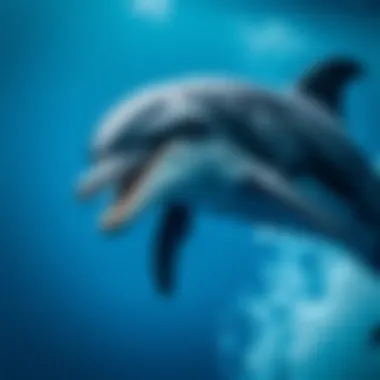
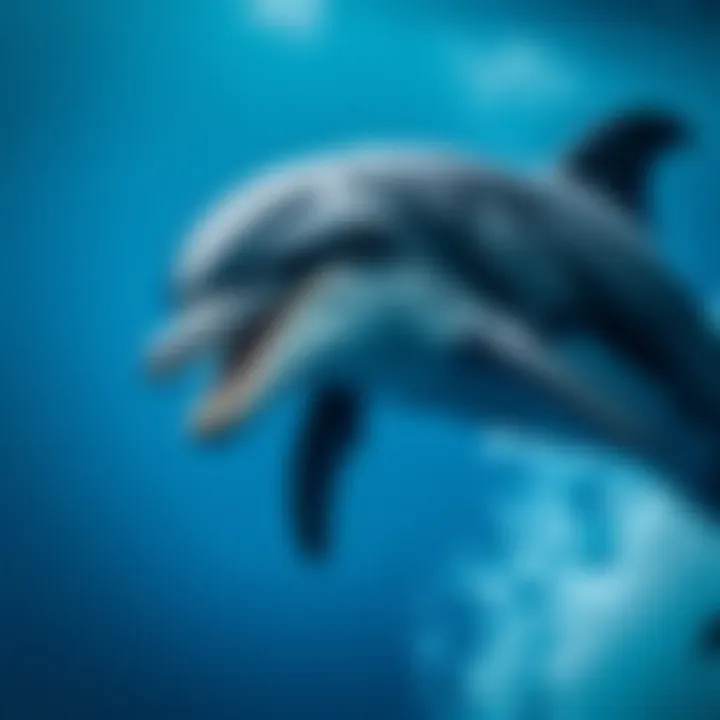
Threats to Their Population
Bottlenose dolphins face several challenges in today’s world, threatening their populations across various habitats. Understanding these threats is crucial for effective conservation strategies.
- Habitat Degradation: Coastal development has led to the destruction of lagoons and estuaries, which serve as critical nurseries for dolphin prey. Pollution from industrial runoff and nutrient overload further diminishes these vital environments.
- Bycatch in Fishing Gear: Dolphins often become entangled in fishing nets, leading to injury or even death. This accidental capture can significantly impact local populations. Ultimately, indiscriminate fishing practices pose serious risks.
- Marine Traffic: Increased boat traffic can lead to disturbances in dolphin behaviors. The noise pollution from vessels interferes with their communication and navigational abilities, affecting their feeding and social interactions.
- Climate Change: As water temperatures rise and oceanic ecosystems shift, dolphins may find their food sources dwindling. Alterations to migratory patterns and prey abundance are looming threats that could disrupt established feeding grounds.
Bottlenose dolphins require urgent attention; without collective conservation efforts, we run the risk of losing these remarkable beings.
Conservation Efforts
In light of the multitude of threats, various conservation efforts are made worldwide to protect bottlenose dolphins. These initiatives not only serve to safeguard dolphin populations but also promote healthier marine ecosystems.
- Protected Marine Areas: Establishing marine protected areas plays a critical role. In these areas, fishing is limited, and dolphins can thrive without the usual threats of human activity.
- Stricter Fishing Regulations: Implementing measures such as bycatch reduction devices in nets can help mitigate incidences of entanglement. Advocating for responsible fishing practices can contribute to dolphin conservation.
- Public Awareness Campaigns: Educating the public through informative resources and outreach programs raises awareness about dolphins and encourages eco-friendly practices. Engaging the community empowers them to participate in conservation efforts.
- Research Initiatives: Ongoing studies focused on dolphin behavior, population dynamics, and health provide critical data that informs conservation strategies. Collaboration among scientists, conservationists, and policymakers enhances the effectiveness of these efforts.
By working together, we can create a sustainable future for bottlenose dolphins and the diverse ecosystems they inhabit.
Efforts to protect bottlenose dolphins must be multifaceted and sustained, integrating community involvement and scientific research, ensuring our ocean is a safe haven for these intelligent animals. For those interested in diving deeper into this topic, resources such as NOAA, Marine Conservation Society, and Cetacean Society International can provide valuable insights.
Cultural Significance
The significance of bottlenose dolphins in culture cannot be overlooked. These marine creatures have weaved themselves deeply into the fabric of human narratives, art, and social symbolism. Understanding this cultural layer adds another dimension to our appreciation of these dolphins beyond just their biological and ecological roles. It highlights the ways in which dolphins resonate with human beings, often reflecting our values, narratives, and emotional experiences.
Representation in Literature and Media
Bottlenose dolphins have captured the imagination of writers, filmmakers, and artists alike. In literature, they often serve as symbols of intelligence and freedom. One poignant example is the book "The Old Man and the Sea" by Ernest Hemingway, where the protagonist's spirit intertwines with the beauty of the ocean, evoking a sense of harmony with nature.
In popular media, films like Flipper and documentaries such as The Cove showcase these dolphins, emphasizing their playful nature and intelligence while simultaneously raising awareness about conservation issues. They embody a sense of connection with nature and the wild. Their representations often serve as a reminder of the delicate balance between humanity and the natural world. Once, a famous quote said, "Dolphins are the dolphins of the sea," highlighting their unique charm and stature in nature and human culture alike.
Books, documentaries, and even animated features have contributed to a rich tapestry of dolphin portrayals that celebrate their grace and sentience. Whether depicted as mystical creatures or intelligent companions, their representation invites viewers and readers to reflect on broader social issues—like environmental conservation and the ethical treatment of animals.
Symbolism Across Cultures
Dolphins hold varied meanings in different cultures. In many Indigenous cultures, they are viewed as guides or protectors, often symbolizing playfulness and joy. The Maori people perceive them as symbols of wisdom and kinship. In Hawaiian tradition, dolphins are seen as "aumakua," or ancestral spirits, connecting the living with their heritage and the ocean’s sanctity.
Conversely, some mythologies depict dolphins with darker undertones, associating them with both celebration and sorrow. For instance, in ancient Greek and Roman myths, dolphins are often linked to the idea of resurrection and transformation, playing pivotal roles in the storylines of gods and heroes. This duality in symbolism can highlight the complexity of human emotions and relationships with the natural world.
Furthermore, their graceful movements and social behavior have earned them a place in art and folklore. From being depicted in ancient pottery to appearing in modern tattoos and design, dolphins symbolize the connection between humans and the ocean. They remind us of our shared environment, embodying the spirit of curiosity and adventure.
In summary, understanding the cultural significance of bottlenose dolphins provides us with a lens to explore human emotions, ethical considerations, and the ever-evolving relationship between humanity and the natural world. As they navigate their habitats, so too do they navigate the deep waters of human culture.
Research and Study
Research on bottlenose dolphins is not just a curiosity; it carries significant weight in the fields of marine biology, ecology, and conservation. Understanding these creatures through scientific inquiry sheds light on their behavior, social structures, and the challenges they face in today's oceans. An exploration of research and study offers a pathway to comprehend not only the dolphins themselves but also their role in the larger marine ecosystem.
Methodologies in Marine Biology
Marine biologists employ a variety of methodologies when studying bottlenose dolphins, combining traditional techniques and modern technology to gather data effectively. The primary methods include the following:
- Field Studies: Researchers often observe dolphins in their natural environments, which can include everything from coastal regions to offshore waters. Such studies are crucial for understanding their behaviors, social interactions, and responses to environmental pressures.
- Acoustic Monitoring: By using underwater microphones, or hydrophones, scientists can capture the sounds dolphins make. This approach helps in deciphering their vocalizations and understanding communication patterns.
- Tagging and Tracking: Some researchers use satellite tags or suction-cup attached devices to track dolphin movements and migration patterns. This provides data on swimming speeds, depth usage, and habitat preferences.
- Genetic Analysis: Collecting biological samples, such as skin or blubber, allows for genetic analysis to learn about the population dynamics and health of dolphin communities.
These methodologies enable a more holistic understanding of bottlenose dolphins. By observing them and gathering data from various angles, researchers can draw informed conclusions about their behavior and ecology.
Current Studies and Findings
Current studies on bottlenose dolphins yield fascinating insights with real-world implications. For instance, ongoing research seeks to identify the effects of climate change and human activity on dolphin populations. Some key findings include:
- Social Structures and Bonds: Recent studies reinforce the complexity of dolphin social systems and how strong familial bonds can influence group behavior and survival.
- Impact of Pollution: Scientists are increasingly recognizing how pollutants, such as plastics and heavy metals, disrupt dolphin health and their reproductive success.
- Adaptations to Changing Environments: Observations illustrate that bottlenose dolphins are adapting to new challenges in their habitats, though not all adaptations have positive outcomes.
- Behavioral Studies: Innovative behavioral research shows that bottlenose dolphins can exhibit behaviors traditionally associated with humans, like cooperation, which pushes the boundaries of our understanding of intelligence in non-human species.
“Research is the foundation upon which conservation efforts rest; without understanding, all efforts could be in vain.”
In essence, the ongoing research surrounding bottlenose dolphins contributes immensely to marine biology, offering critical understanding that shapes conservation strategies and highlights the need for awareness about these intelligent creatures. For more detailed information on marine biology methodologies and findings involving bottlenose dolphins, you can visit reputable sources like Britannica or Wikipedia.
Ending
The world of bottlenose dolphins opens up a fascinating interplay between nature and intellect, captivating our imaginations and stirring our curiosity. It’s not merely their acrobatics or playful behavior that holds our attention, but the complex network of traits that underpin their existence as a species.
Recap of Key Points
In this article, we’ve explored significant aspects of bottlenose dolphins, each layer revealing something deeper:
- Cognitive Abilities: Their problem-solving skills and use of tools demonstrate a level of intelligence that rivals many terrestrial animals.
- Social Structures: The sophisticated dynamics of pods reveal not just a form of social life but also intricate roles played by individual dolphins, creating a vibrant community.
- Communication Techniques: The blend of vocalizations and non-verbal cues showcases how these creatures express their needs and emotions, forming a unique language that connects them.
- Physical Adaptations: From streamlined bodies to echolocation abilities, their adaptations are not just functional but also vital to their survival in varying aquatic environments.
- Conservation Status: Understanding the threats they face and the ongoing conservation efforts can shed light on the importance of preserving not just dolphins but the broader marine ecosystem they represent.
Future of Bottlenose Dolphins
As we gaze into the future, the outlook for bottlenose dolphins holds both promise and concern. Conservation efforts are gaining momentum, with a focus on sustainable practices and habitat protection. Community engagement and scientific research can stimulate a shift towards better understanding these mammals.
Additionally, advancements in technology may allow researchers to dive deeper into dolphin behaviors and health, potentially unearthing insights that can support more robust environmental policies. The challenge remains for humanity to align their interests with those of these intelligent beings, ensuring that both can thrive in a shared ecosystem. Will the future bring a harmonious relationship between humans and bottlenose dolphins, or will it tighten the threads of vulnerability these creatures face?







